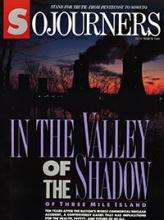"GO TO THE TOP OF THE HILL AND MAKE A RIGHT AT THE TURKEY Hill Minit Market; cross the railroad tracks and keep going until you pass a red brick church on your left...." As I sat in my office in Washington, D.C., taking these directions to a stranger's house over the phone, I was picturing every landmark. My sisters and I had frequently ridden our bikes over these rolling hills of Central Pennsylvania. This was home.
The anticipation of returning just before Thanksgiving encouraged memories of 15 years of holiday journeys back. By this time every year, the plentiful Pennsylvania corn stalks were cleared away, leaving acres of golden stubble poking through a light dusting of snow. The geese and I sometimes met head-on, they making their way south through this valley carved out by the Susquehanna River. Seeming to point the way for them and me, white candles always glowed softly in every window of familiar, old farmhouses, whose chimneys breathed out lazy curls of smoke. Often as I hit the final stretch, a setting sun would splash brilliant red behind silhouettes of stately barns.
My parents moved to a piece of farmland in Elizabethtown about the same time I moved to Washington. They built a house that, by their description before it materialized, would be "perfect for the grandchildren," with plenty of space for Mom's flowers and Dad's vegetable garden.
I grew up down the road in Hershey--"Chocolatetown U.S.A." Hershey kids had the advantage of taking frequent tours through the chocolate factory for the reward of a free candy bar. My sisters and I spent long summer days in the town's amusement park, riding one of the oldest merry-go-rounds in the world and stopping off to sip chocolate-flavored Cokes at the counter of the Hershey drug store before heading home. I learned to water-ski on the Susquehanna at the age of 7.
Read the Full Article

